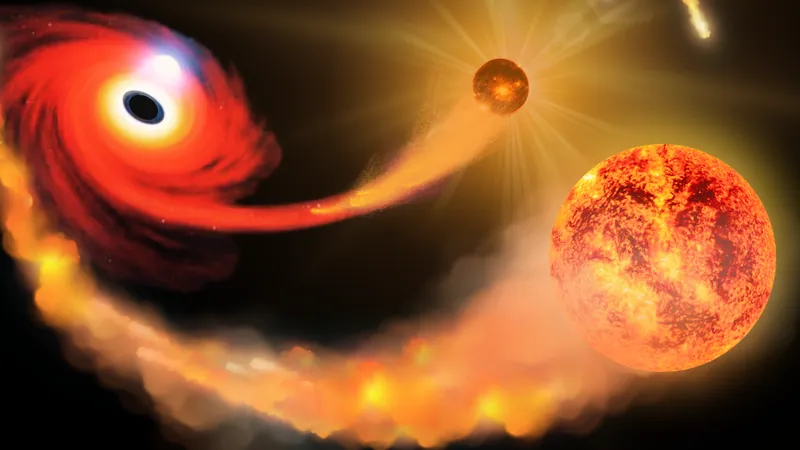
Star Escapes a Supermassive Black Hole's Grasp: A Cosmic Drama Unfolds
2025-01-10
Author: Mei
In a stunning celestial ballet, astronomers are witnessing the extraordinary behavior of a supermassive black hole that has recently double-flashed in a remarkable Tidal Disruption Event (TDE) known as ASASSN-22ci. This event, occurring approximately 408 million light-years away in the galaxy WISEA J122045.05+493304.7, could unveil the secrets behind the enigmatic phenomenon of repeating TDEs.
TDEs occur when a star ventures too close to a black hole, succumbing to its immense gravitational forces. In the case of ASASSN-22ci, astronomers believe that the black hole has disrupted a binary star system, allowing one of the stars to escape while devouring the other. "This is not just a simple meal; it’s a cosmic event that can be observed from billions of light-years away," explains Jason Hinkle, a leading astronomer at the University of Hawaii.
The initial flash was spotted in February 2022, appearing to be an ordinary TDE, but the astronomical community was left astounded when the black hole flared again 720 days later. This second flash of ASASSN-22ci is significant as it’s among the very few TDEs known to have erupted multiple times. Hinkle highlighted how this event is pivotal: "Our understanding of TDE physics could change drastically from these observations, as they allow us to examine the early phases of TDEs with unmatched detail. "
Delving into the science, the black hole responsible for this spectacular show is estimated to have a mass of around 3 million times that of our Sun, slightly lighter than Sagittarius A*, the supermassive black hole at the center of the Milky Way. Scientists suspect the star involved in the flares could be around the mass of our Sun, though the status of any potential binary companion remains uncertain.
The gravitational forces exerted by the supermassive black hole lead to a process known as "spaghettification," where stars are stretched and torn apart into thin strands of stellar material. This material forms an accretion disk around the black hole, where it gradually gets consumed. What remains of the binary system is influenced by a process called Hills capture, where one star is flung away at high velocities while the other is trapped in a resulting elliptical orbit.
"This orbit brings the remaining star back close to the black hole multiple times, leading to events like ASASSN-22ci", said Hinkle. The periodic approach can trigger repeated flares as the star endures several rounds of disruption. If the remaining star passes within the tidal radius of the black hole upon its return, it can suffer further disruptions, generating more flares over time.
Moreover, astronomers are eagerly anticipating a potential third flare from ASASSN-22ci. Based on the 720-day interval between the first two flares, they predict that the next one could occur in early 2026. Hinkle stated, "If our model holds true, this would allow us to prepare for observations to capture the event as it unfolds. "
Should the third flare not materialize, it could suggest varied outcomes—either complete disruption of the star during the second flare or the possibility of the earlier flares being separate, unrelated events. The anticipated third flare offers astronomers a rare opportunity: to study the early phases of a TDE with foresight, something that’s typically a gamble as such events are unpredictable.
The potential discovery of a third flare could yield profound insights into the workings of black holes and the fates of stars unfortunate enough to stray too close. This unfolding dramatic tale of cosmic destruction and survival embodies the intriguing complexities of our universe and opens new frontiers in astronomical research that could redefine our understanding of black hole behaviors.

 Brasil (PT)
Brasil (PT)
 Canada (EN)
Canada (EN)
 Chile (ES)
Chile (ES)
 Česko (CS)
Česko (CS)
 대한민국 (KO)
대한민국 (KO)
 España (ES)
España (ES)
 France (FR)
France (FR)
 Hong Kong (EN)
Hong Kong (EN)
 Italia (IT)
Italia (IT)
 日本 (JA)
日本 (JA)
 Magyarország (HU)
Magyarország (HU)
 Norge (NO)
Norge (NO)
 Polska (PL)
Polska (PL)
 Schweiz (DE)
Schweiz (DE)
 Singapore (EN)
Singapore (EN)
 Sverige (SV)
Sverige (SV)
 Suomi (FI)
Suomi (FI)
 Türkiye (TR)
Türkiye (TR)
 الإمارات العربية المتحدة (AR)
الإمارات العربية المتحدة (AR)